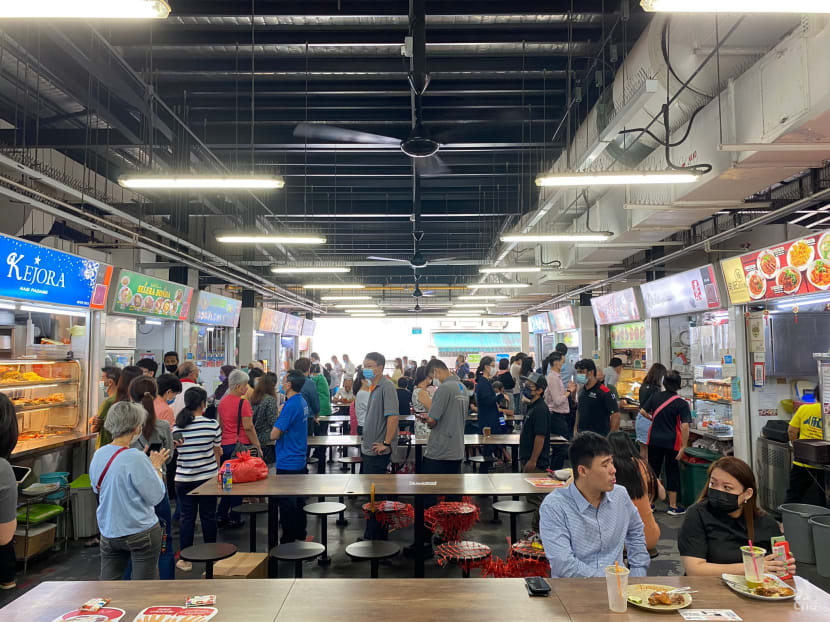Commentary: With Omicron threat, will returning to offices and schools bring new anxieties?
It sounds counter intuitive to dread greater freedom of movements as we move into endemic living but there are those who feel an acute sense of fear, says a KTPH psychologist.

Office workers at Market Street Interim Hawker Centre on Jan 3, 2022. (Photo: CNA/Grace Yeoh)
SINGAPORE: Soon after the COVID-19 pandemic started, a friend of my part-time cleaner – let’s call her Madam Lee – stopped work completely.
The 56-year-old had been working as a cleaning lady for homes but decided it was not safe to continue. She cut down almost all interaction with the outside world.
Two years on, vaccines have been delivered to the majority of Singaporeans and safe management measures are implemented to help us live with the virus. But Madam Lee is still staying home most of the time and unwilling to venture out.
Singapore has put in place a system that will allow us to live with the virus. And even with new variants emerging, gradual reopening is happening. From Jan 3 (Mon), work from home is no longer the default arrangement and 50 per cent of employees can return to the office. Larger work-related events of up to 1,000 people can also take place with safety measures in place.
Bigger crowds have been a common sight in our malls especially during the festive season – with some revellers going overboard when thousands gathered at Clarke Quay to usher in the new year.
There appears to be two groups of people – those who simply cannot wait for things to get back to normal and those who feel a sense of fear that this reopening will somehow lead to cases rising.
Set against the backdrop of Omicron infections increasing in Singapore, the impending return to normalcy will likely cause Madam Lee’s anxiety to grow even more out of proportion. And there are many like her.
Most Singaporeans polled in a survey reported by the Straits Times last year said it was unrealistic to live with restrictions indefinitely – suggesting they wanted to move on to endemic living. But 10 per cent were willing to live with restrictions beyond two years.
This group may remain cautious, anxious, or may even find reopening dangerous – a reaction that some experts have termed “re-entry anxiety”.
This is also born out in studies overseas. In a report published by the American Psychological Association in March 2021, almost half of the respondents felt uneasy about adjusting to in-personal interaction after the pandemic, regardless of the vaccination status.
ANXIOUS ABOUT “OLD NORMAL”
It sounds almost ironic that we are not comfortable with getting back to the “old normal”. But living a secluded lifestyle for almost two years has created new habits in all of us.
For instance, we are so used to keeping safe distances, we get anxious when we see larger crowds. Or we instinctively move away when someone near us coughs or sneezes.
My observations of people's feelings point to how complex this is: We want things to be normal yet are fearful of change.
Neuroscience research shows that our brains are wired to be resistant to change because the emotional brain – the amygdala – interprets change as a threat. Reversing back to the “old normal” can be perceived as particularly threatening and challenging especially since the trajectory of the pandemic is still uncertain.
If this affects most of us, then one can imagine the challenge it poses to people with pre-existing anxiety issues. For them, the secluded lifestyle provided temporary relief in the form of avoidance and consequently reduced the triggers of their anxiety.
However, based on the "operant conditioning" theory, first described by the American psychologist, B F Skinner, this prolonged state has the effect of intensifying their anxiety in the long run. When the temporary relief is about to “break down”, they may experience an increased in anxiety.
In the case of Madam Lee, she coped with the pandemic by shutting the world out, instead of understanding that the safe management measures can be tapped on for protecting her from infection. This unhelpful way of thinking (where nothing is in her control) and avoidance strategy (always staying at home) formed what we call a maladaptive coping mechanism, which would make her adjustment to re-entry much more difficult.

ADJUSTING WELL TO REOPENING
The key is to avoid adopting an all-or-nothing mentality.
It is probably not a good idea to be seeking out and staying in crowds all the time, just as you do not have to be cooped up at home all the time. If you are anxious or have family members who are, start leveraging on your daily routines to create more opportunities to be familiar with being outside home.
Getting groceries during non-peak hours instead of ordering them online or making the effort to take a short walk in the neighbourhood before returning home after work are some small practices to start with before gradually working up to more challenging tasks.
Similarly, staying updated on COVID-19 developments does not mean doom-scrolling for COVID-19 news the whole day from different sources – but neither does it mean avoiding all news completely. Set aside a bit of time (no more than 30 mins) once a day just to read the most salient updates on official news channels.
Some folks are still wary of heading back to the office even though a testing regime is put in place. Instead of worrying about all the potential downsides, it may be better to see it as an opportunity to catch up with your colleagues whom you have not seen for so long and to brainstorm for new ideas for the coming year. These face-to-face interactions are critical.
Related:
Avoidance, or hiding from COVID-19, prevents us from challenging irrational thoughts. We need to step out gradually to get used to the “old normal” with time.
The infrastructure for managing COVID-19 has been established in Singapore but beyond that, we too have grown more resilient and have acquired an adaptive mindset after living with frequent changes. So now, even if things change, we have the benefit of experience to live with these changes more readily now.
When we spoke, I encouraged Madam Lee to externalise her attention and observe that her friends who have been working and going out in the past months have not been infected. This helps to challenge her all-or-nothing mentality that there is a high chance of catching the virus once she leaves home.
She should also move on to make some actual behavioural changes by meeting up with close friends whom she trusts for a short gathering or progressively increase the duration of such catch-ups. These social connections are critical to our mental health too.
Adaptation takes place naturally with time. Like Madam Lee, all of us can focus on what is in our control and start making plans to adjust to reopening.
Mabel Yum Po Shan is Head and Principal Clinical Psychologist of Psychology Service at the Khoo Teck Puat Hospital.











